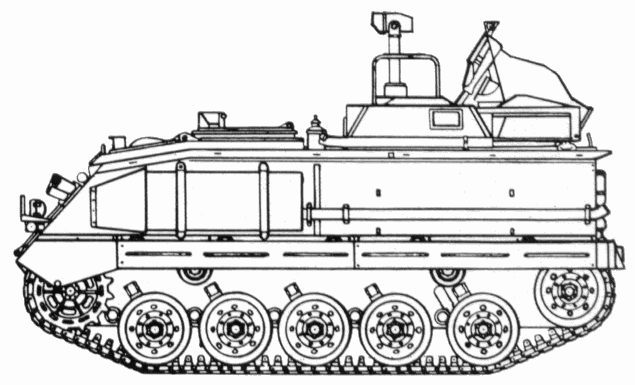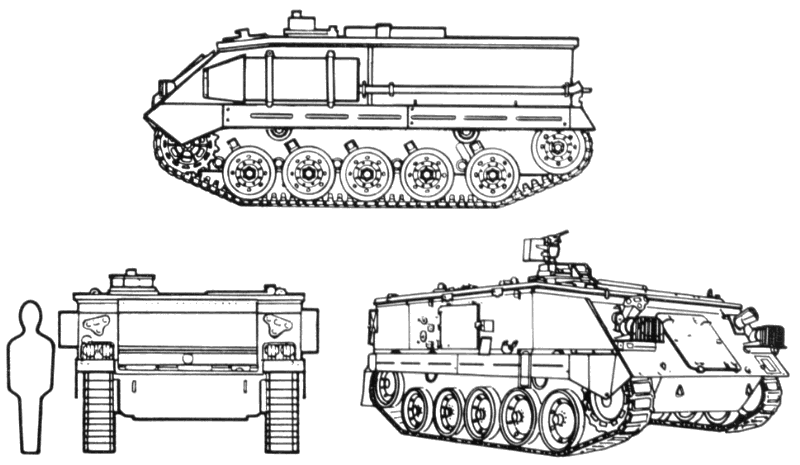About 3,000 of these APCs were produced from 1963 to 1971.
Newer models have the NBC pack on the right side of the hull which is almost flush against the hull rather than protruding, as on earlier vehicles.
Many automotive components of the FV432 APC are used on the FV433 Abbot 105mm self-propelled gun.
Most FV432s are expected to remain in service, and many will undergo automotive improvements including a new steering and braking unit.
The all-welded steel hull protects against small-arms fire and shell splinters.
On the front right side is the driver's hatch cover that opens to the left.
The hatch has a wide-angle periscope.
Behind the driver is the commander's cupola that can be traversed through 360°.
The cupola's hatch cover has three periscopes. A 7.62mm machine gun is directed out the front of the cupola.
Air inlet and outlet louvers are on the roof above the engine compartment on the left front.
A forward-opening hatch on the glacis plate provides access to the steering system.
The rear troop compartment seats 10 infantrymen on two benches running down the sides.
These fold up for a cargo capacity of 8,090 pounds (3,670 kg).
There is a large door in the rear of the troop compartment with a vision block.
In the roof are large circular hatch covers that open to both sides and fold in the middle.
An NBC system on the right side of the hull gives fresh air for the troops.
Unlike the similar M113 APC, the FV432 is not amphibious without preparation.
The FV432 must be prepared with a flotation screen erected with ten stays around the top of the hull.
A trim vane goes up in front, and an extension goes on the exhaust pipe.
When floating, it is propelled by its tracks. Most of these vehicles have had their amphibious capability removed.
The torsion-bar suspension has five dual rubber-tired road wheels, two track-return rollers, and a drive sprocket in front.
Friction shock absorbers are on the first and last wheels. Rubber-bushed steel tracks have removable rubber pads.
Recognition Features:
- Fully tracked.
- Five road wheels.
- Similar to the M113A1.
- May or not have a small turret.
- Long, rectangular-shaped body.
- Exhaust pipe runs along the left side of the hull.
- NBC pack on left forward side of hull.
A few FV432s issued to the Berlin Brigade were armed with the same 30mm RARDEN cannon as mounted on the turret of the Fox armored car.
Many are fitted with a lightweight turret with 7.62mm machine gun. This turret has a rear-opening hatch cover, three periscopes, and four smoke dischargers on either side.
The turret is over the front part of a circular troop compartment hatch that replaces the original four-part hatch.

- Ambulance
- The unarmed ambulance carries four stretcher patients or two stretcher and five seated patients. The stretchers are easily loaded with sliding swivel racks.
- Carl Gustaf
- A Swedish 84mm Carl Gustaf anti-tank weapon may be mounted with a bar across the top of the troop compartment. The standard armored personnel carrier (APC) may also carry a Euromissile MILAN ATGW which is deployed away from the vehicle.
- Command
- The seven-crew command model has two mapboards and extra communications equipment. More room can be made by erecting a penthouse measuring 3.6 x 2.74 x 1.98 meters.
- 81mm Mortar Carrier
- This is the basic vehicle equipped with an 81mm L16 mortar on a turntable which is mounted in the rear of the hull, and can be traversed through 360 degrees. The mortar has a range of 5,660 meters and 160 mortar bombs are carried. The vehicle has a crew of six.
- FV434 Maintenance Carrier
- Designated the FV434, this model is used mainly to change major components in the field, such as the complete powerpack of the Chieftain MBT. There is a crane on the right side of the vehicle which has a lifting capacity of 3,050 kg. The suspension of the FV434 can be locked when the crane is being used. The vehicle has a crew of four.
- Minelayer
- The FV432 is used by the Royal Engineers to tow the Bar minelayer which can lay mines at a rate of 600 per hour. A THORN EMI ranger anti-personnel minelaying system can be mounted on the top of the FV432 to enable a combined anti-tank and anti-personnel minefield to be laid.
- Radar
- A large scoop-shaped antenna protrudes from the FV432 when mounted with a mortar-locating radar or a short-range radar system.
- Recovery
- This is the basic FV432 with a winch installed in the rear troop compartment. The winch is driven from the PTO on the engine transfer case.
- Royal Artillery Vehicles
- The FV432 is used in an artillery battery command role when fitted with the Marconi Command and Control Systems Field Artillery Computer Equipment and the Plessey sound ranging system.
- Royal Engineers Vehicles
- In addition to using the FV432 as a minelaying vehicle as previously described, the Royal Engineers use it to tow the Giant Viper mine-clearance trailer.
- FV438 Swingfire
- This variant is equipped with a Swingfire ATGM.

- FV438 Wavell
- A command and control Wavell automatic data processing system is recognizable by a large external box on the roof.
- FV439 Royal Signals Vehicles
- Designated FV439, this model has extensive antenna arrays on the roof for specialized communications.


